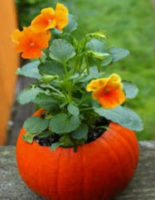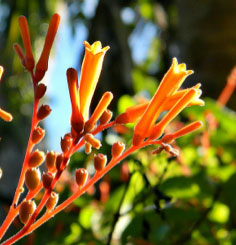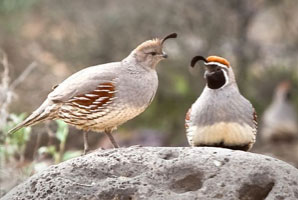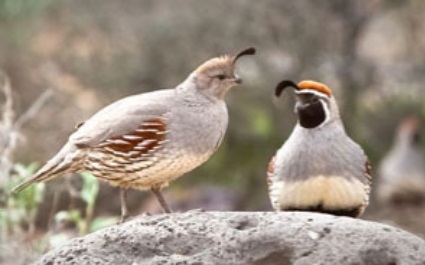
Happy Halloween from all of us at Goomdan’s! There is cooler weather just around the corner along with the trick or treaters. A fun pre-Halloween event is having a pumpkin carving party. Start with a family trip to your local pumpkin patch to pick out several pumpkins. Let your children draw a design, or trace stencils on the pumpkins as a guideline for carving. They can also scoop out the interiors and sort through the mess to pull out the seeds. The seeds then get washed and put on a tray for toasting in the oven. The seeds toast fairly quickly and can be used as a party snack. Leave the carving to the adults.

Texas Firecracker Bush (Hamelia patens) – Plant of the Month
This lovely tropical plant blooms from spring to fall. As an added bonus when cooler fall temperatures prevail it’s normally bright green foliage gets a lovely bronzy tinge to it. As with all tropical type plants it will suffer damage if temperatures dip too low. Plant it in area that will get some respite from the sun in the afternoon hours when the sun is at it’s most intense. At maturity this shrub is about 3 to 4 feet high and wide. If you’ve planted it in an area where it’s size will be an asset, it will require little to no pruning. The flowers are tubular and do not open more than pictured at right. Humming- birds love this plant! It’s also rumored to have a some homeopathic properties. Click here for more information.
Gambel’s Quail (Callipepla gambelii) – Critter of the Month
Gregarious and social, Gambel’s quail form covey’s in the fall and winter to forage for seeds, grasses, fruits, berries, cacti and other herbaceous material. Population size is directly correlated to the amount of rainfall during the previous October through March. The more rainfall the higher the population. Makes sense right? The more rainfall, the more food available.

Gambel’s breed in spring and early summer and chicks hatch, all in the same day, approximately 3 weeks after eggs are laid. Baby quail emerge at about 1 inch tall and are able to see, walk and eat soft vegetation immediately. As soon as the group has their strength, their parents lead them off to forage for more food. Although mortality rates for offspring are high, Gambel’s make up for it by laying between 10 to 12 eggs per nest.
Unlike other birds, Gambel’s love dry baths. Bath time consists of scratching and pecking to create loose soil. Then they hunker down in it, and quickly fluttering their wings to spread dirt throughout their feathers. When they emerge from their bath, they puff out all their feathers and shake vigorously sending dust and dirt flying. They may complete the entire cycle several times if undisturbed. If you live in an area they frequent and feel safe in, your flower beds and pots make an ideal bathing/snacking spot due to the looser and slightly moist soil and foliage. Inexperienced mother’s may even consider your pots or flower beds the ideal nesting/nursery.



